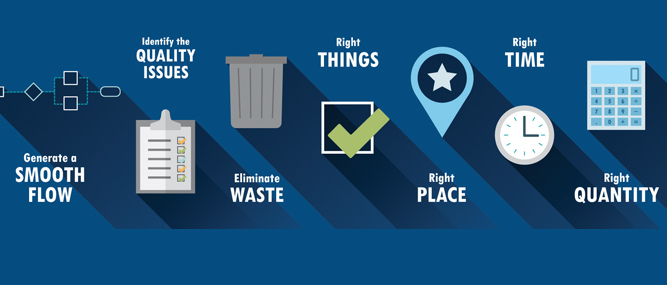Efficient companies look to find ways to identify and eliminate waste. In modern lean thinking strategies, eight waste areas have been identified that are common to most manufacturing operations. The first seven were cataloged by Toyota engineers decades ago. And an eighth was added to cover the waste of human potential and skills.
Waste is defined as any step or action in a process that is not required to complete a process. This is a step that doesn’t add any real value to the process. It just adds complexity and cost. These are steps or actions that the customer doesn’t really want to pay for. Let’s examine these eight areas and how they can be a drain on pallet and lumber companies.
1. Transportation
Unnecessary movements of products, people, tools, inventory or materials.
This can lead to unnecessary work and transportation expenses. Eliminating this movement may decrease the environmental footprint of a product, as well as wear and tear on employees.
Examples: Excessive trucking or forklift movements.
2. Inventory
Excess products and materials that are not timely processed.
While excess inventory may seem like an asset to an accountant, it smacks of wasted capital for lean managers. Excess inventory can result from over-purchasing of raw materials, over production of components or products or unnecessary bulk purchasing. This waste can lead to defects, poor cash flow and component problems hidden in bulk inventories. Not to mention you have to store, manage and get rid of extra inventory. Potential solutions include stream lining purchasing processes to only buy when needed or creating ques to prevent overproduction.
Examples: Excess raw materials (lumber of nails) purchased to get a good deal. Broken down machines could fall into this category, as well as excess pallets produced in the hopes that customers will buy them as safety stock.
3. Motion
Unnecessary movement by people.
Typical examples include: walking, lifting, reaching, bending, stretching and moving. Tasks that require excessive motion should be redesigned to enhance the work of personnel and increase the health and safety levels. The best place to start is to look at the workspace for production employees. Is it optimized to reduce steps or improve ergonomics for workers?
Examples: Too much walking for pallet repair personnel to sort or stack pallets. Another example is improper layout for hand nailing stations. Tools are put in the improper place that adds unnecessary steps. Poor plant layout causes wasted motion by forklift operators.
4. Waiting
Wasted time waiting for the next step in the process.
Some people call these bottlenecks. Waiting between various processes usually results from unevenness in production stations or machinery speeds. Potential solutions include redesigning processes to ensure continuous flow or cross training workers so that people know how various aspects of the process interact.
Examples: Waiting for materials to arrive, such as the right lumber sizes. Machinery running at different speeds due to bottlenecks or poor design or lumber sortation. Workers waiting for instruction resulting from improper order communication. Another common problem is equipment with insufficient capacity.
5. Overproduction
Production that is more than needed or before it is needed.
Overproduction occurs when a product or component is produced before it is required. It may be tempting to produce as many products as possible when there is an idle worker or equipment time. But this leads to a number of problems, such as higher storage costs and wasted capital. You want to analyze various stations to ensure that the production levels are even. Also, using a pull system where components are produced only when needed to fulfill an order can help eliminate overproduction.
Examples: Manufacturing overproduction involves producing more pallets or lumber than demanded through a ‘push production system’ or producing products in higher batch sizes than needed.
6. Over-processing
More work or higher quality than is required by the customer.
Over-processing refers to doing more work, adding more components, or having more steps in a product or service than what is required by the customer. In a manufacturing or recycling process, this could include using higher precision equipment than necessary, using components with capacities beyond what is required, running more analysis than needed, over-engineering a solution, adjusting a component after it has already been installed, and having more functionalities in a product than needed. The key to fixing this issue is always starting with the customer in mind and producing to his/her expectations.
Examples: Using excessive automation to produce or recycle pallets. Another example would be over designing a pallet and using more lumber than necessary.
7. Defects
Efforts caused by rework, scrap and incorrect information.
Defects occur when the product is not fit for use. Customers will complain and require a replacement product. This typically results in either reworking or scrapping the product. To remedy defects, look for the most common one and focus on fixing it. You can also design a process to inspect final products for defects, as well as standard production processes to eliminate variances from station to station.
Examples: Improperly marked pallets or inconsistent sizing of lumber or pallets. Producing products by hand may result in more dimension and production variance.
8. Human Potential
Underutilizing people, especially talents, skills or knowledge.
This waste occurs when organizations separate the role of management from employees, thereby creating barriers. The experiences of frontline workers are not relayed to managers. The people doing the work may see the problems before anyone else, but they have no access or standing to convey concerns efficiently to management. As a result, human potential, talent and ingenuity is wasted. A solution is to create opportunities for management to regularly talk with and observe workers, as well as actively seek their input.
Examples: Poorly trained employees may not know how to effectively operate machinery, or they may be given the wrong tools for the job. Production workers may be too complacent, feeling their input to improve things will be ignored.





